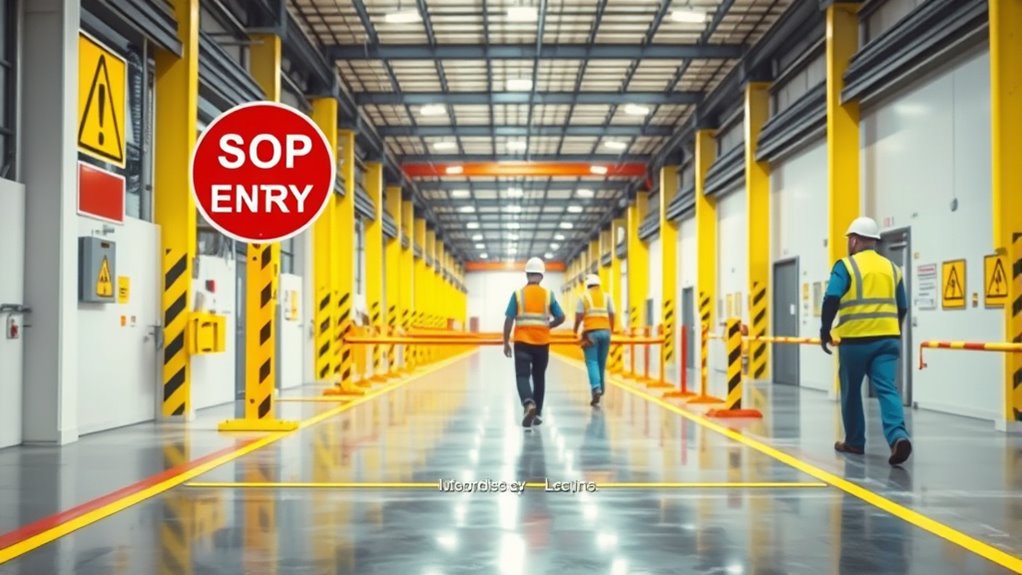Safety and regulations are key to keeping your workplace secure by helping you identify hazards early and ensuring you follow industry standards. These practices protect your workers, assets, and the environment, while reducing accidents and damages. Staying compliant involves regularly reviewing safety measures, documentation, and communication. It creates a proactive safety culture and demonstrates your commitment to a secure environment. Keep exploring to discover how continuous hazard identification and compliance can benefit your workplace even further.
Key Takeaways
- Safety regulations provide a framework to protect workers, assets, and the environment through established standards.
- Hazard identification is essential for proactive risk management and ongoing safety improvements.
- Compliance standards set minimum safety requirements, guiding equipment, training, and procedures.
- Non-compliance can result in fines, legal issues, and increased accident risks, undermining safety efforts.
- Integrating hazard identification with compliance fosters a continuous safety management cycle and a safety-oriented culture.

Have you ever wondered why safety and regulations are so essential in various industries? The truth is, they serve as the backbone of a secure working environment, protecting workers, assets, and even the environment. One of the fundamental elements in maintaining safety is hazard identification. This process involves carefully examining your workplace to spot anything that could potentially cause harm. Whether it’s a slippery floor, exposed wiring, or faulty machinery, recognizing these hazards early on allows you to take proactive steps before accidents happen. Hazard identification isn’t a one-time task; it’s an ongoing process that keeps safety at the forefront of daily operations. By systematically identifying risks, you can implement targeted control measures, reducing the likelihood of injuries or damage down the line.
Hazard identification is an ongoing process vital for maintaining workplace safety and preventing accidents.
Compliance standards play a crucial role in guiding hazard identification efforts and ensuring that safety measures are consistently upheld. These standards are established by regulatory bodies and industry organizations to set minimum requirements for safe practices. When you adhere to compliance standards, you’re not just following rules—you’re actively creating a safer environment. These standards help you determine what safety equipment to use, how to train your team, and what procedures need to be in place. For example, OSHA regulations in the United States specify specific safety protocols for handling hazardous materials or operating heavy machinery. Staying compliant means regularly reviewing your safety procedures, updating practices in line with new regulations, and making sure everyone understands their responsibilities. Additionally, incorporating safety technology can further enhance hazard detection and compliance efforts, leading to a more comprehensive safety strategy.
Failing to meet compliance standards can have serious consequences, including hefty fines, legal liabilities, and, most importantly, accidents that could have been prevented. That’s why integrating hazard identification into your safety program is so vital. It’s not enough to just know the hazards; you need to systematically document them, communicate risks clearly to your team, and implement controls that meet or surpass compliance standards. Doing so demonstrates your commitment to safety and minimizes risks that could lead to injury or operational disruptions.
In essence, hazard identification and compliance standards go hand-in-hand. They form a continuous cycle that emphasizes proactive safety management. By staying vigilant and committed to these principles, you create a workplace where safety isn’t an afterthought but a core value. When you prioritize hazard identification and diligently follow compliance standards, you’re not only protecting your team and assets but also fostering a culture of safety that benefits everyone involved.
Frequently Asked Questions
How Often Are Safety Regulations Updated?
Safety regulations are updated regularly, often every few years, depending on industry changes and new safety insights. You should stay proactive by conducting safety audits and risk assessments frequently, which help identify when regulations might need revision. By keeping up with these updates and integrating new safety standards into your procedures, you guarantee compliance and maintain a safe environment for everyone involved.
Who Enforces Safety Compliance Standards?
Surprisingly, it’s you who enforces safety compliance standards, even if it doesn’t always feel like it. You’re responsible for ensuring proper safety signage and protective equipment are in place. Authorities set the rules, but it’s your job to follow and enforce them daily. When in doubt, remember that ignoring safety standards can lead to serious consequences, so stay vigilant and proactive in maintaining a safe environment for everyone.
Are There Penalties for Non-Compliance?
Yes, there are penalties for non-compliance. Penalty enforcement occurs when authorities conduct compliance audits and find violations. You could face fines, sanctions, or other disciplinary actions if you don’t meet safety standards. Regular audits are designed to guarantee adherence, and failure to comply results in consequences that can impact your operations. Staying proactive and maintaining compliance helps you avoid penalties and ensures a safe environment for everyone involved.
How Can I Report Safety Violations?
Imagine spotting a safety violation like a flickering light in a dim corridor. You can report it through your company’s reporting procedures, which are designed to be straightforward. Start by documenting the violation and then submit your report via safety audits or designated channels, such as an online portal or direct contact with safety officers. Prompt reporting helps make certain of swift action and a safer environment for everyone.
What Training Is Required for Safety Certification?
You need to complete specific safety certification courses relevant to your industry, which often include training on proper safety gear usage. These courses typically cover essential safety procedures, hazard awareness, and emergency response. After successfully finishing the certification, you’ll receive a credential verifying your safety knowledge. Make sure to stay updated with mandatory retraining sessions, as they help guarantee you’re always prepared and compliant with safety standards.
Conclusion
Remember, staying safe and following regulations isn’t just a modern-day concern — even in the age of chivalry, knights knew the importance of rules. By always adhering to safety guidelines, you protect yourself and others, preventing mishaps that could turn your day into a real Pandora’s box. So, don’t be a knucklehead. Embrace the rules like a trusty steed, and you’ll avoid trouble, proving that good safety habits are timeless, no matter what era you’re in.
With a heart that soars as high as the skies, Aria, affectionately known as “Skylark,” is the driving force behind Soaring Skyways. Her journey into the gliding world began as a young dreamer gazing up at the soaring birds, yearning to experience the weightlessness and freedom they embodied. With years of experience both in the cockpit and behind the scenes, Aria’s commitment to the gliding community is unwavering.





